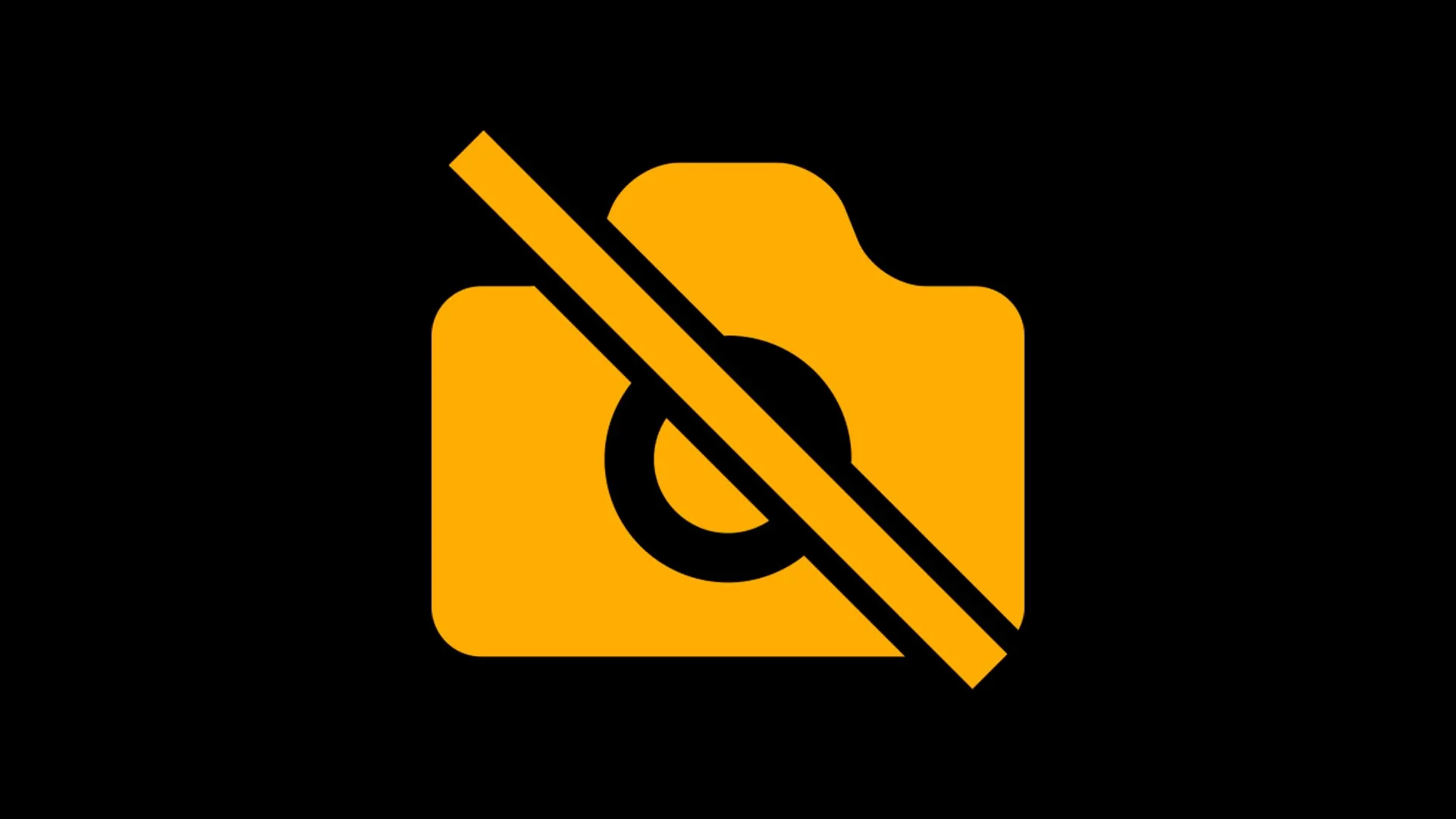You have an expertise that you want to teach.
But recording video courses in front of a camera?
Phew. Sounds like a nightmare.
I stared at my laptop, confused.
Every “course expert” was preaching the same thing:
“You need professional lighting! Get an HD camera! Master video editing!”
They made it sound like you needed a Hollywood studio just to teach online.
Since I didn’t know better:
- I bought the softboxes.
- I bought the bulky backdrops.
- I also bought the microphones and the tripods.
I was sitting in my tiny 1-bedroom apartment with the kids screaming in the other room. But all this sounded way too confusing to me.
It took me an hour to get a setup I thought was good (but it looked like crap).
This was back in 2013.
Since then, I’ve created close to 100 online courses and made over 1 million $ in course sales.
Here’s what a decade of course creation has taught me: All that “professional video” stuff? It’s a distraction. A myth that keeps talented people from sharing what they know.
Let me show you how to create an online course without having to appear on camera. Ever.
The most s*xiest business model on the planet
I love creating (and making money) with online courses.
It’s the best way to profit from your knowledge.
Unlike $19 ebooks, online video courses have high-perceived value.
You could sell them somewhere from $50-$1000. (How much you can charge for it depends on several factors like the market, the problem you’re solving, etc. And that’s a topic for another day.)
Once you’ve created your course, it keeps selling without you having to show up every time. Instead of helping one student at a time, you can teach hundreds or even thousands at once. Plus, students can be from anywhere in the world. Even in totally different time zones.
An online course costs almost nothing to start. Seriously.
All you need is:
- Your computer
- Your brain & knowledge
- And some tools to start recording (most of them are free or dirt cheap).
And zero:
- Staff
- Fancy office
- Heavy upfront costs
The best part? You’re actually solving problems for people while having the freedom to work when and where you want.
Yet… most Creators give up Too early
95% freeze before they even start.
That voice in your head says, “Who am I to teach others?” or “There are already so many courses out there.”
Impostor syndrome hits hard, even when you know your stuff cold.
Then comes the tech part which showers most with overwhelm:
- Editing videos
- Setting up cameras
- Dealing with lighting
- Picking the right platforms
And you know what? The first video recording is usually awful.
You hate how you sound.
You’ll stumble over words.
And you’ll probably want to delete everything.
Almost everyone feels awkward and unnatural at first.
Getting stuck in endless research & procrastination is common. You might spend months “getting ready” or trying to make everything perfect.
Some people never launch because they’re always adding “one more thing” to the course.
I remember when I launched my first courses. I’d spend WEEKS getting the PowerPoints right.
And even with all that prep, it still ended up with embarrassing typos.
Then, there’s the fear of negative reviews:
- What if people hate it?
- What if they ask for refunds?
- What if they point out mistakes?
These thoughts can prevent you from actually recording your course for months.
Perfectionism is real.
Many burn out trying to make their first course.
They try to cover everything, create 100 videos, and end up exhausted before they even launch. Or they get halfway through and realize they need to re-record everything because they’ve gotten better at presenting.
Give your DSLR the finger
All this is normal. I went through it myself.
Creating an online course is not just about creating the material. It’s also about launching it so that you can make money with it.
I won’t lie: There are a lot of moving parts like:
- Designing a logo
- Finding a catchy title
- Creating a sales page
- Deciding on the right pricing
- Writing an email launch sequence
- Uploading your course to your LMS
- And the list goes freakin’ on
But if there’s one thing that will make the process 10 times easier, it is to give your DSLR the finger.
And here’s the truth most course creators won’t tell you: Your first version will probably be just okay, not amazing. And that’s fine – you can always improve it later.
The hardest part isn’t creating the perfect course. It’s simply starting and finishing something that’s good enough to help your first students.
PERFECTIONIST INSIDER TIP:
Your students don’t buy a course to see your face on camera. What they’re buying is a solution to a problem.
And there are multiple ways to help people without having to show your pretty face.
⌨️ Courses without camera: Text-based courses
What if instead of recording video lessons you’d simply write them out?
Think of it as scripting the lessons and then having them inside a member’s portal.
There are creators who sell text-based courses like copywriter Andre Chaperon or my colleague John Bejakovic:
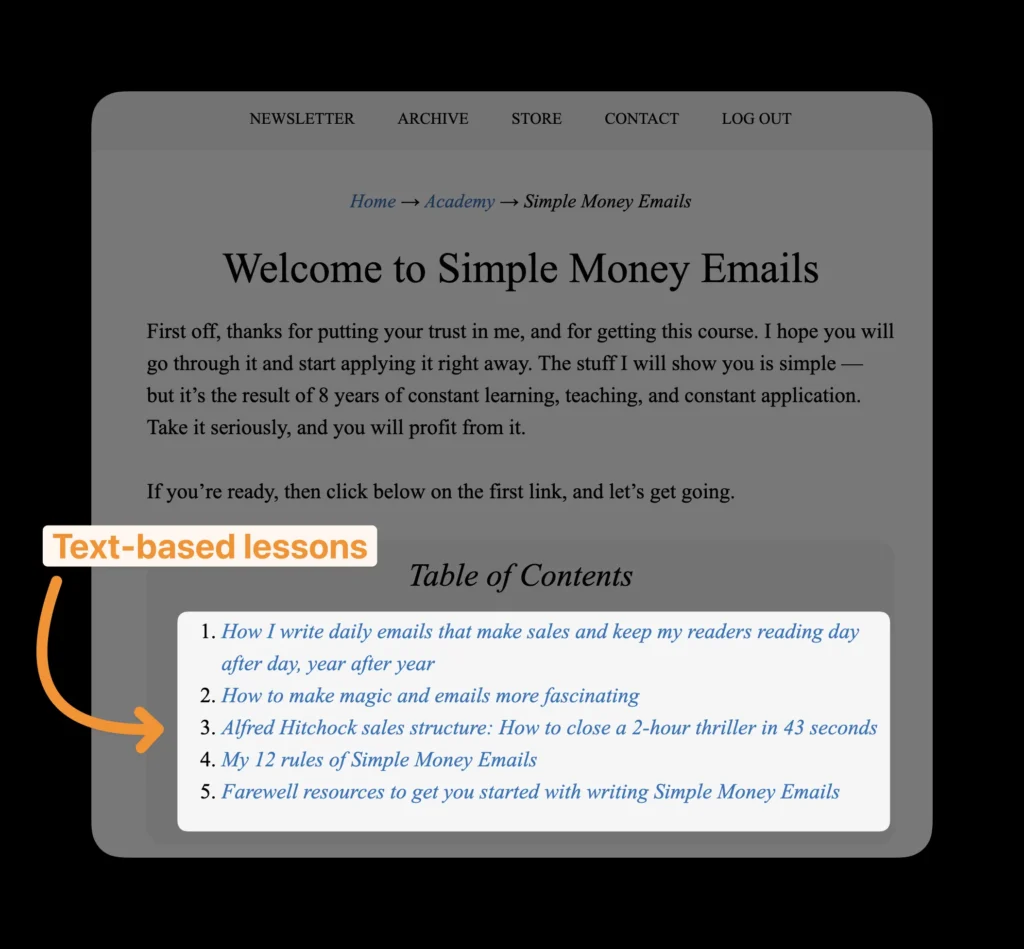
For many people, writing is easier than talking.
So if that’s you, you might give writing out lessons a try.
📨 Email courses
Email courses are seriously underrated.
Think about it – you could simply write a set of emails and sell it for $97.
Shorter than an ebook. But 10x more profitable.
Your students get one email a day for 30 days. This works great because it forces your course to be actionable. Not just stupid theory.
There’s no video editing, no fancy equipment. Heck, you don’t even need a course-hosting platform to deliver it. It can all be done straight in your autoresponder.
People love these because they can digest the content during their commute or lunch break. Plus, many prefer reading to watching videos.
The key is making each email actionable and valuable on its own.
🖥️ Record Your Freakin’ Screen
I won’t lie: Having video lessons makes your course more valuable.
Just record your screen – whether you’re showing how to use software, breaking down spreadsheets, or analyzing examples.
Tools like Descript, Loom, or ScreenFlow make this super simple.
Now you might be asking: What to record?
Well, this depends on what exactly you’re teaching.
If you’re teaching stuff like coding, what makes the most sense is to record yourself coding. (Sounds crazy, I know.)
That’s what I do when, for example, I show my students how to use AI or Obsidian for note-taking:
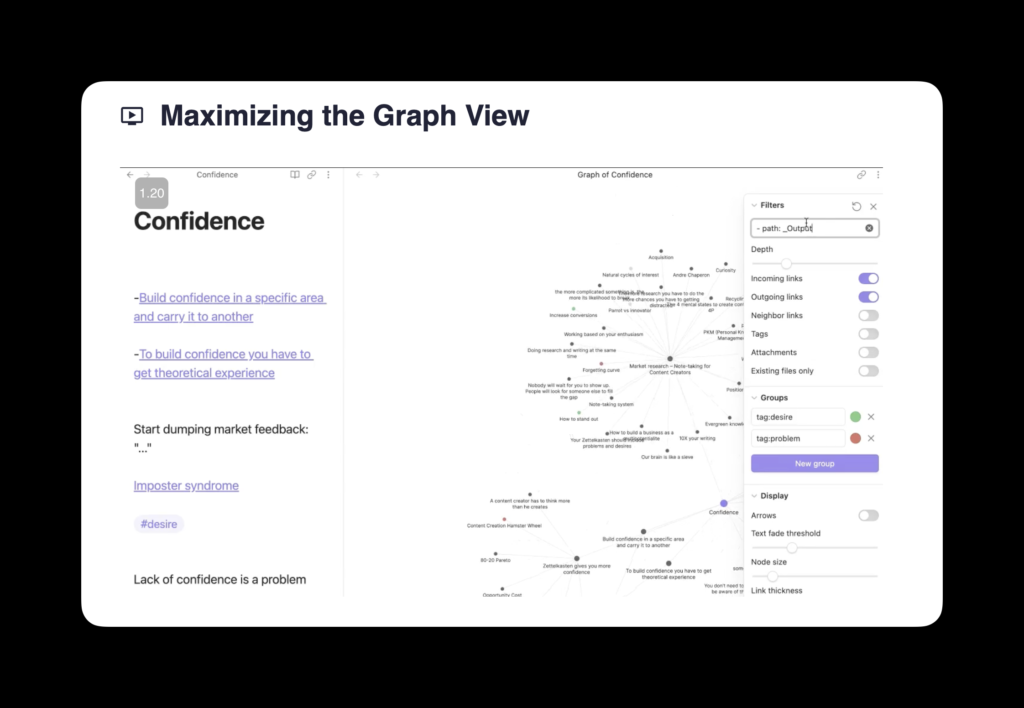
Many creators also create Loom-type videos where you see the screen and then a very tiny video of their webcam/external camera:
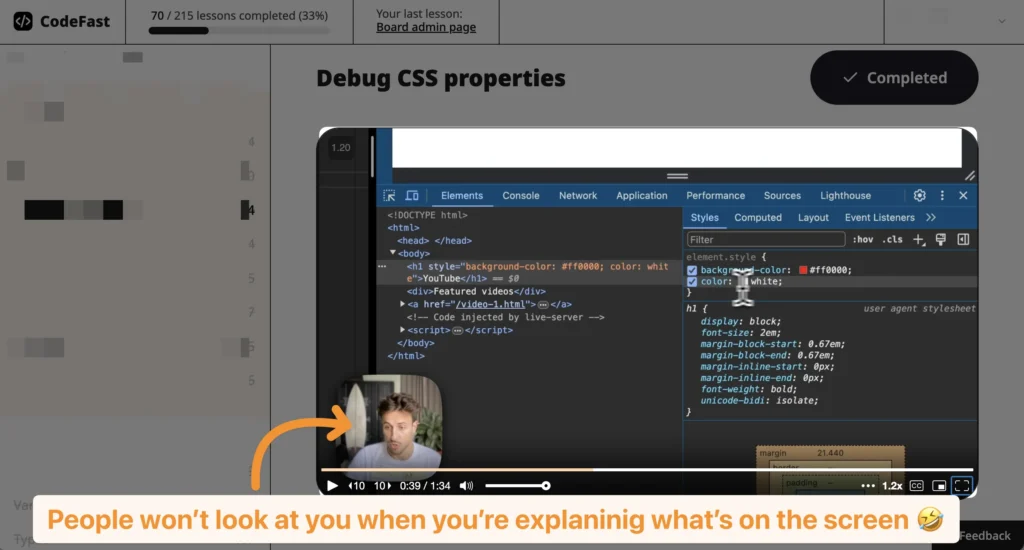
If you’re more comfortable writing out your lessons, you can then turn them into video lessons later on and record yourself commenting on a Google Doc.
This is probably the easiest way to create video courses without being on camera.
🗺️ Mind maps
This is my favorite method and the one I’ve been using for my latest courses.
I brainstorm and create my course outline on a mind map. It allows me to organize my ideas and dump them as soon as I have them.
I usually work on my mind map for 3-5 hours depending on the complexity of the topic I’m teaching.
Then once I’m done, all I do is record my screen, commenting on the mind map:
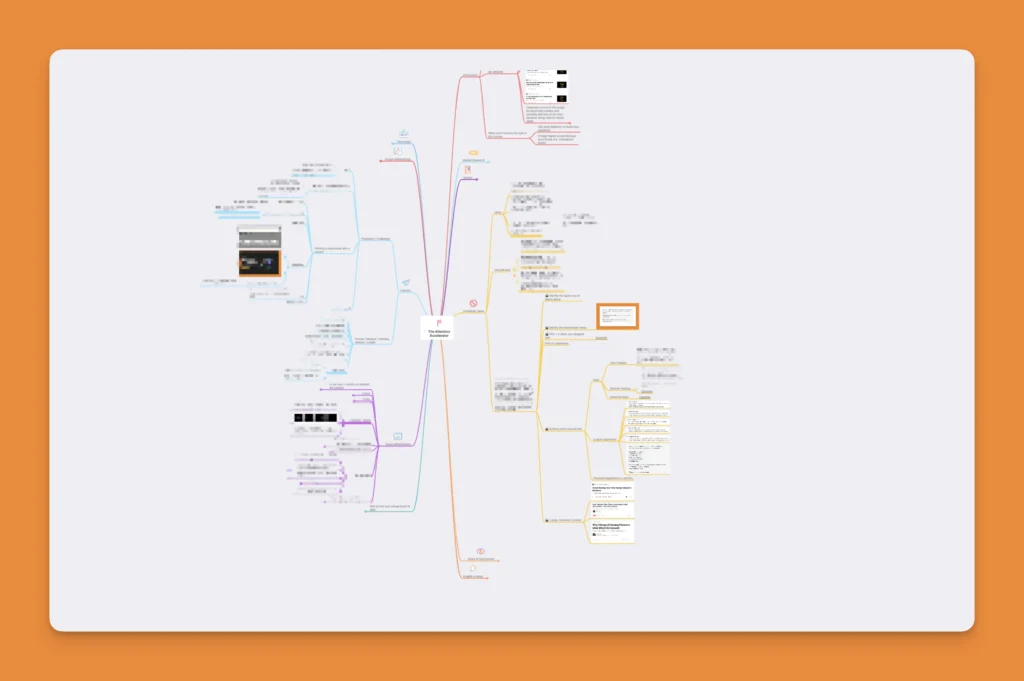
It’s easy and interesting to follow because of the branches and colors.
Plus, it feels natural because nothing is scripted. Simply add bullet points and examples about what you want to talk about.
🎨 Digital drawing: the iPad method
For introverts like me, screen recording is king.
But it doesn’t have to be these boring Keynote presentations.
If you’ve got an iPad or drawing tablet, you can create engaging visual content by recording yourself drawing, sketching, or annotating.
You could simply use Apple’s built-in Notes app, your Apple Pencil, and start screen recording (make sure it also records your microphone).
Here’s an example of what it looks like from one of my courses:
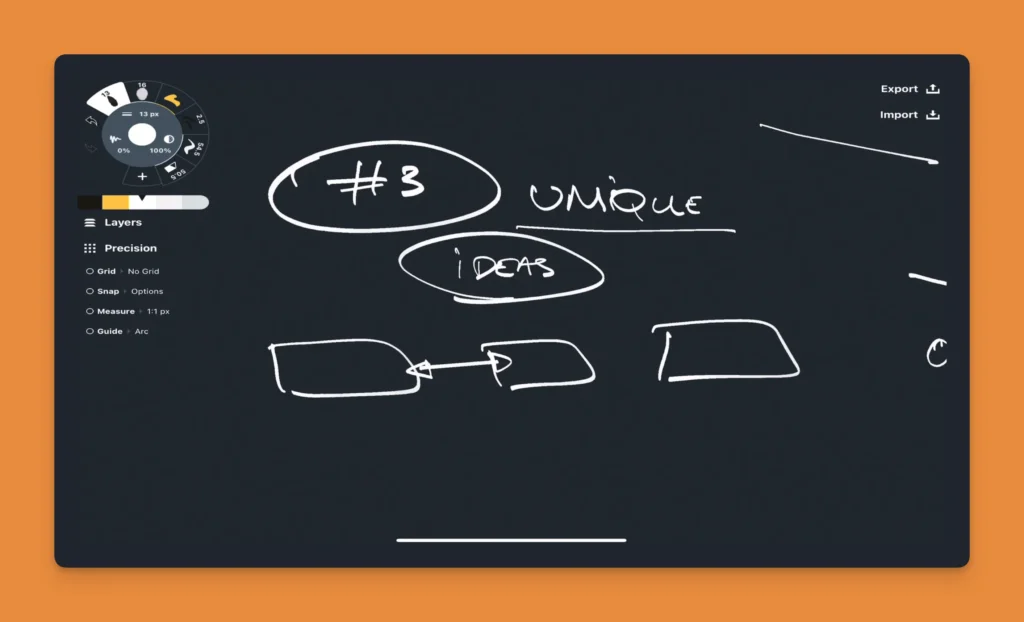
Even if you’re a bad drawer like me. It’s perfect for everything from art tutorials to math explanations.
Many of my students reported that they loved the drawing teaching style. So it’s definitely a great way to record a full online course without having to show your face.
Conclusion
Here’s the most important thing about all these methods: Choose the one that feels most natural to you.
If you’re forcing yourself into a teaching style that feels uncomfortable, it will show in your course.
The best format is the one where you can be yourself and teach naturally.
Students can tell when you’re genuinely comfortable with your teaching method – it makes the whole learning experience better for everyone.
Some of the most successful courses out there don’t show the instructor at all. The value is in your knowledge and how clearly you can share it, not in how you look on camera.

